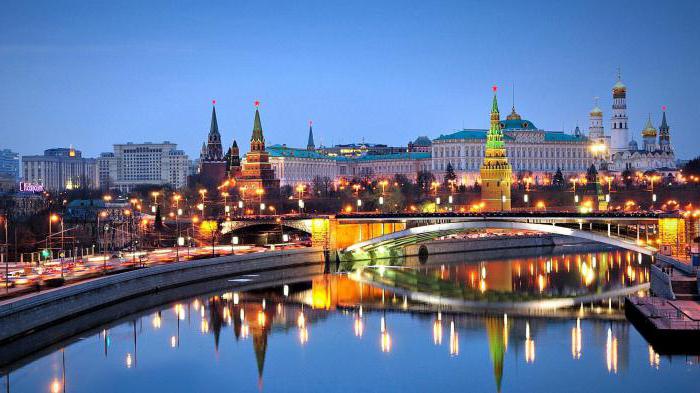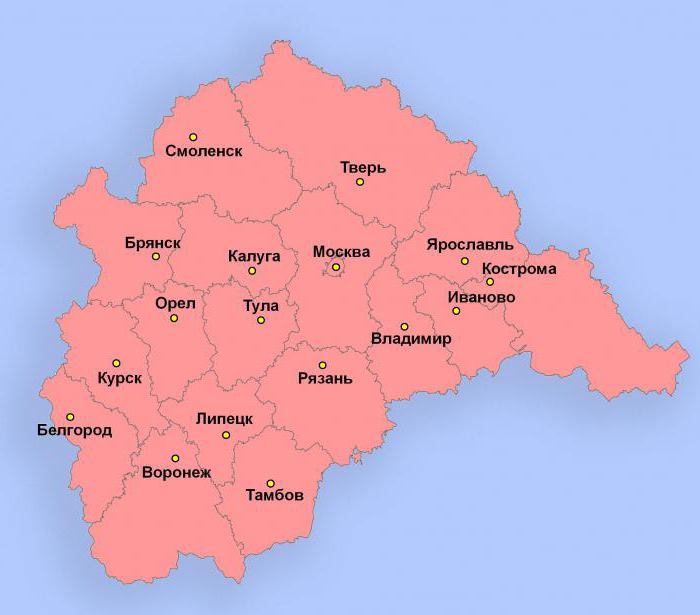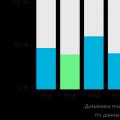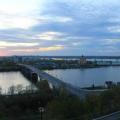CENTRAL FEDERAL DISTRICT (CFD)- formed on May 13, 2000 in accordance with the Presidential Decree Russian Federation No. 849 "On the Plenipotentiary Representative of the President of the Russian Federation in the Federal District." The territory of the district is 650.3 thousand square meters. km. (3.8%) of the territory of Russia and ranks first in Russia in terms of population. Central Federal District is located in the central part of the East European Plain, its administrative center is Moscow.
Everything seems to indicate that the city tends to reproduce traditional cultural patterns. This hidden bias in the reproduction of traditional patterns and this asymmetry between traditional social space and modern physical space can be one of the obstacles to the processes of change in the city. The question arises: can a city, by its characteristics of political capital, strive for other functions that go beyond the bureaucratic, no matter how important they are?
The characteristics that are usually applied to so-called global cities, although not exclusive, have some emphasis on their main economic sector and therefore on the socio-professional profile of a portion of their population. Still in the process of establishing itself in front of the Brazilian urban network, Brasilia has a central factor in its identity in the public sector. It is therefore necessary to ask the extent to which the hegemony of the public sector sets up its particular culture.
(Central Federal District), which includes 18 subjects of the federation, plays an extremely important role in the life of our country. Here are the main administrative, political, scientific, economic and economic, leading educational, medical and other significant centers and structures of Russia, its main and often world significance objects of culture, art, as well as natural heritage(many of them are included in the List of World Cultural and Natural Heritage Sites).
And so we could check if this sector is still a determinant in the perception that the city produces for its residents and for the external public to the central core of the federal district. Therefore, we mean a group that, in addition to ancient history in the apparatus of the Brazilian state, has the stability guaranteed by the hierarchy created among them, and a slow but safe career. This set of elements gives this group a distinctive pose.
It is important to note that the bureaucracy is a hierarchical group in which the adaptation of each person to the spirit of government is not uniform. The creation of new professional vacancies in the public sector allows the introduction of new personnel, many of whom have not previously learned the ideal of a “good employee”. And it can be added that these people have little chance of redefining the social behavior of this category. In general, high ranks in the hierarchy of administration are accompanied by a high monetary nature and additional state benefits, which can significantly increase the standard of living of the population.
The city of Moscow is the country's largest center for finance, trade, science, higher education, culture and art. The Moscow region accounts for about half of all scientific research in Russia. Other large cities of Central Russia are also important centers of science and higher education.
The largest in terms of the number of constituent entities of the Russian Federation, it unites 2 economic regions: Central and Central Chernozem. The economic and geographical position can be assessed as beneficial for the development of the economy, especially for the manufacturing and non-manufacturing sectors.
Central Federal District plays an extremely important role in the country's economy, has a high level of socio-economic development. As a capital district, the district is the leader among other districts not only in terms of population, but also in the development of economy, finance, science, culture, higher and secondary specialized education, in terms of the density of rail and road networks.
Natural conditions on the territory of the Central Federal District are favorable for the development of most sectors of the economy.
Central Federal District poor natural resources, especially in relation to the large needs of the economy and a large population - the exception is stocks iron ore, for which the district ranks first among all regions of Russia.
The main branches of market specialization of the Central Federal District are in industry - diversified mechanical engineering, chemical, light (textile) industry, in agriculture - the cultivation of sugar beets, sunflowers, cereals, vegetables and dairy and meat cattle breeding. In addition, for activities economic complex The district is of great importance for the electric power industry and the construction materials industry.
The leading industry in the district is mechanical engineering. Its development was facilitated by a favorable economic and geographical position, the availability of qualified labor resources, the proximity of scientific centers, large production ferrous metals. The second most important industry in the Central Federal District is metallurgy.
Central Federal District ranks first in Russia in the production of building materials, but they are not enough for intensive construction in the district.
We can assume that, in general, senior officials have a right to expect material and symbolic rewards commensurate with their duties and responsibilities. Although this group maintains hegemony in the configuration of the parameters of Brazilian culture, it is necessary to take into account the heterogeneity or internal diversity of the group, which is often far from the “deep Brazil” that still characterizes the Central-West region. Despite this hegemony in the public sector, the dynamics of the population of the federal district and its environs is significantly higher than it.
One of the leading agricultural regions of the country. But the agriculture of this district does not meet the needs of its large population for basic types of food. A significant part of the food in the Central Federal District is products from other regions of Russia or imported. The main agricultural subsectors are the cultivation of cereals, sugar beets, potatoes and vegetables, as well as dairy and beef cattle breeding, pig breeding and poultry farming.
Considering the Federal District and expansion environment, there is a historical process of strange population growth, as demonstrated earlier. However, demographic growth and the gravitational pull of federal capital cannot be explained solely by vacancies in the state bureaucracy. These demographic dynamics indicate an expansion that surpasses the real incentives of the public sector and its ability to absorb growth in its workforce.
Our statements are still with high level abstraction and need an achievement that can be achieved with data on the relative participation of various economic activities and socio-professional categories in the federal district. Table 3 shows that over the past ten years, the segment of economic activity that had the lowest growth relative to the number of available jobs was the share of government, which grew by 29%, while industry and civil construction grew by 112%, and the segment of trade and services for the same period increased by 61%.
CENTRAL federal district
... Area 652,800 sq. Km.
Administrative center of the federal district - Moscow city
Administrative center of Belgorod
- Administrative center of Bryansk
- Administrative center of Vladimir
- Administrative center of Voronezh
- Administrative center of Ivanovo
- Administrative center of Kaluga
- Administrative center of Kostroma
- Administrative center of Kursk
- Administrative center of Lipetsk
That is, it is remarkable that in the federal district and its surroundings there is a whole chain of production processes and that it functions separately from the logic of the state bureaucracy. At the same time, the dependence of the state of the machine remains. Although some regions of the federal district are mainly composed of civil servants, there are others that are consolidating and becoming dynamic from different logics. While the pilot plan still concentrates much of the city's leisure and cultural equipment and continues to stand out as the federal district's main employment and income center, regions such as Taguatinga, Seilandia, Gama and Samambai have emerged in the federal capital, important sub-regional economic poles.
The Central Federal District includes 18 territorial entities. And for this reason, it is the largest in terms of their number. There are no republics in the Central Federal District, only regions and the only one which is the capital of our country, Moscow. By the way, she is not only largest city the entire district, but also its administrative center. However, first things first.
General considerations: a plan to embed Brazil's potential in the global network of cities. The analysis presented in the previous pages demonstrates some of the features of the Brasilia metropolis that help us outline our hypothesis that the urban area of the Federal District fills some aspects of a potential global city. We have selected some of the aspects that subsidize us in this direction: the local economy, population dynamics and the implications for the population profile guided by the characterization of the city-state.
Peculiarities
Before considering the composition, it is worth noting the features that distinguish it.
So, the Central Federal District was formed on May 13, 2000. He has no outlet to any sea and, accordingly, the ocean. But nevertheless, this is the largest district in terms of population and the number of territorial entities, as already mentioned above. A little more than 39 million people live in the Central Federal District. This is approximately 26.7% of the total number of citizens of the Russian Federation. The density, by the way, is ~ 60.14 people per km².
We also insist on the urban design of its central core, which captures a kind of urban imagination. The economic vitality of the area, which has a strong dynamism, is notable from the outset. Another aspect, which is derived from the analysis, is that here, as in other modern megacities? production and appropriation of territory form a whole, consisting of parts with differentiated logics, which are visualized in their own morphology of the territory of the cities that make up the metropolis.
The Central Federal District includes two large economic regions, which include 310 cities. These are the Central Black Earth and Central regions. The area occupied by them is 650 205 km². This is approximately 3.8% of the entire territory of Russia. But, despite such small dimensions, the Central Federal District is the basic macro-region of the entire country.
In addition to the pilot plan with radically rational urbanism, what is in other urban areas of the region is various forms of occupation of the territory, forming “fragments”, each with its own dynamics. In this metropolis, we have also observed administrative districts striving to achieve a greater degree of autonomy in the face of the strong polarization carried out by the pilot plan.
This original image of Brazil, in which satellites were destined for the lower echelon of government and where "unwanted" ones were sent, is less and less obvious. Urban logic has spread throughout these territories to give them prominence in the country's network of cities. This urban dynamism is uneven, is it enough to observe? with the usual exceptions? that the low-income population is moving towards increasingly distant periphery, occupying lands bordering the state of Goias, the so-called environment.
Capital
As mentioned above, Moscow is part of the Central Federal District. It occupies the smallest area when compared with other subjects of the Central Federal District - only 2,511 km². But, despite this, on average 10 times more people live in Moscow than in other areas of the district. There are 12,330,126 people in the capital, according to the latest statistics.
It should be noted that even if Brasilia was born under the sign of rational planning, there is territorial fragmentation here, i.e. a factionally urbanized territory, the occupation of which takes place in the early years and is currently beginning to experience intense occupation.This phenomenon is also repeated in other metropolitan areas of the country, as the creation of new centralities differs from the functionality of the experimental plan, which currently imposes a diversified use of the territory opposite to the logic of origin ...
What can you tell about Moscow? After all, this is the capital, and that says it all. Still, it should be noted that the city is the largest financial center on a national scale and one of the world's largest business megacities. And perhaps it will not be superfluous to say that it is Moscow that is in first place among all cities on our planet in terms of the number of dollar billionaires living on its territory. There are 79 of them here. In any case, as of 2011.
Let's take a look at some of the implications of our analysis. However, given the decline of the area and its urban qualities, Brasilia has become a place of residence for people with high income and status. At the same time, this discourse on the valorization of the public sector, which presupposes a homogeneous social block, does not indicate what exists: a set of socially differentiated individuals. This discourse is confirmed by the fact that an important part of its components has one of the most prestigious classification criteria in the social space of the Federal District.
And of course, Moscow is the largest transport hub in Russia. During the year, the volume of passenger traffic is about 11.5 billion people.

Moscow region
This is the next most populous subject of the Central Federal District after the capital. The area of the region is approximately 44.4 thousand km². About 7.32 million people live in this territory.
Thus, living in the Pilot Plan, where it is inhabited primarily by civil servants, is a factor that contributes to the building of social representation of its inhabitants. In other words, the place of residence seems to be a privilege, first of all, the urban, social and economic conditions of numerous satellite cities, which still cannot reach the standards of urban planning in central area... The registration of the Brazilian Pilot Plan by the United Nations Educational, Scientific and Cultural Organization, and then the National Institute of Historical and Artistic Heritage, guarantees the preservation of the central section of the federal district, which seems to protect it from interests, above all from real estate capital and even from certain currents of Brazilian architecture that strive for greater freedom of intervention in the space of the city.
In terms of GRP, the Moscow Region is in third place among all Russian regions. This is a well-developed region, which is facilitated, by the way, by the neighborhood with the capital. On the one hand, this fact plays a positive role. But on the other hand, the capital takes over labor resources area. It's just that many people living in MO work in a metropolis. And for this reason, their taxes go to the Moscow budget.
Thus, although the perception of cities has undergone a change, especially due to the hegemony of the market in the utilitarian concept modern world Brasilia remains "out" of the current floods of urban spaces, which is also exemplified by megastructures in cities in the Middle East and Asia.
It is important to mend these relations, because the influx of major architectural projects to these cities in Asia and the Middle East? the current axis of capitalist dynamics? indicates a new urban logic in global terms. If for centuries the great capitals were the centers of rival powers, today the geopolitics of globalization attracts a multipolar planet, where political capitals are forced to act in synergy. In other words, we left the walled cities for the network cities. In Latin America, in addition to three or four large cities on the continent, we are still relatively shy about participating in this new concept of megacities that are part of the global network of cities.
Industry is well developed in this region. In particular, metalworking and mechanical engineering. It produces rocket and space technology, nuclear and thermal power equipment, mainline diesel locomotives, electric trains, buses, carriages, excavators and much more.

Globalization is currently facilitating cooperation between markets, indicating that a network of cities is being built that is closely interconnected between them, in which Latin America has to insert itself. In these times, when megacities are strategic players in the energy games on an international scale, many of which compete with or even surpass state power, in Brazil, by contrast, the state agent is a privileged ally in the future prospects of city expansion.
This is because, at the risk of adapting to its usual political role, the dynamics of the city point to new directions that are being added to political capital. If this turns out to be the case, Brasilia, as a political capital and with its increasingly diversified economic dynamics, will begin to participate in this global network of cities with relative weight, mainly based on Brazil's position on the international scenario. In other words, the decisions taken in Brasilia have an impact on the entire national territory and to a certain extent on the international forums in which Brazil occupies, which indicates the expansion of power over the nation.
Other regions and their importance
The Central Federal District of Russia also includes Lipetsk region- a region located on a territory that has been inhabited since the Upper Paleolithic (40-12 thousand years ago). So scientists say. 85% of the region's territory is covered with black earth, and 300 mineral deposits have also been discovered here. The Leningrad Region is the leader in the Russian Federation in terms of reserves of carbonate raw materials.
Talking about the composition of federal districts, one cannot fail to note the Ivanovo region, which is part of the Central Federal District. After all, 32.8% of products are produced on its territory light industry from the all-Russian volume (indicator No. 1).
The Oryol region is also included in the Central Federal District. It is distinguished by its economy, which has a pronounced agrarian-industrial character.
Also included in the Central Federal District and Tula region... This is one of the most socially disadvantaged regions. Low fertility, increased mortality, a large number of accidents, poor ecology, and more than 420 thousand people (and in total there are ~ 1,500,000 citizens living in TO) are pensioners. But here it is developed food industry... The most striking example is the Yasnaya Polyana confectionery factory, which produces gingerbreads known throughout Russia.

Features of larger areas
Few of the federal districts can boast of such a variety of territorial entities as the Central Federal District. Not all areas have been listed above.
There is also Belgorodskaya. It is special in that about 40% of the iron ore reserves of the Russian Federation are concentrated on its territory. A good ecological situation is observed in Kaluga region... Sod-podzolic soils occupy 75.6% of its territory. 45.2% of the space is occupied by forests, and the total timber stock, therefore, is 267.7 million m³.
In the Vladimir region, the environmental situation is bad, but mechanical engineering is well developed. Due to this area, about 40% of the industrial product is created.
The Kursk and Tambov regions are also part of the Central Federal District (CFD). The main activity of the first is in the extraction and processing of ore, as well as in mechanical engineering. The industry of the Tambov region is recognized as one of the leading sectors of the regional economy.
The Bryansk region is known for its highly developed railway transport and radio electronics. And also timber processing. The Yaroslavl Region, which also largely determines the important position of the Central Federal District, is one of the most industrially developed regions. About 300 local enterprises are of national importance. In addition, this area is known for its good mineral resources (thin band clays, quartz sand, peat, gravel, etc. are widespread here).

Finally
As you can see, quite solid in economically is the Central Federal District. The composition of the areas, as well as their features, is useful to know. But the last 5 regions have not yet been mentioned. But they are also important.
The Ryazan region, for example, is known for the fact that on its area there are 103.5 thousand hectares of the most important natural areas... And protected, respectively. V Smolensk region dairy and meat cattle breeding is well developed. Agricultural land occupies about 1 750 000 hectares!
Voronezh region is the absolute leader in the whole country in terms of employment. Kostromskaya is known for the presence of the largest enterprises in the Russian Federation specializing in the production of lifting and oil and gas equipment. And finally, the Tver region, the last one. Construction and trade are well developed on its territory.
What conclusion can be drawn? Unambiguous. All areas that make up the Central Federal District are special and valuable in their own way. And thanks to each of them, the Central Federal District is the most highly developed in Russia.




